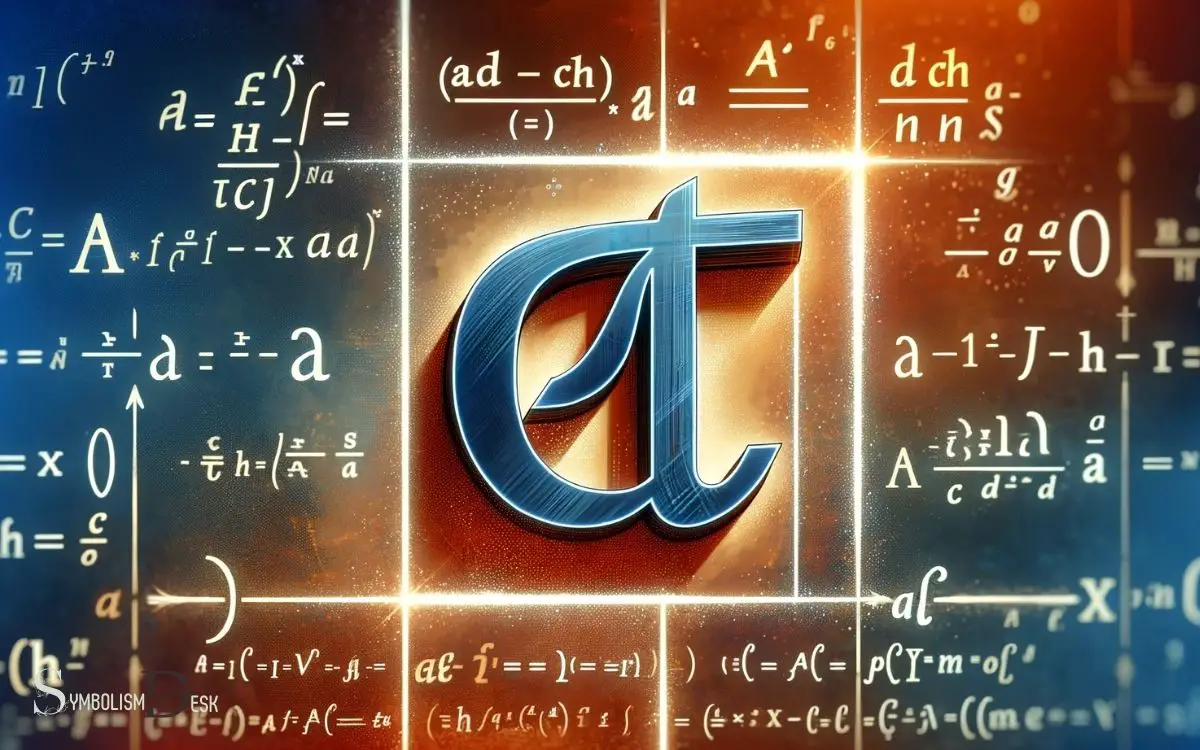For Each Symbol in Math: Geometry!
The guide “For Each Symbol in Math” offers an in-depth look at a wide array of mathematical symbols, covering their meanings and applications across different areas of mathematics.
This resource is tailored to help learners at all levels understand the symbols that are fundamental to arithmetic, algebra, geometry, calculus, and beyond, thereby facilitating a stronger grasp of mathematical concepts and techniques.
Mathematical symbols are the building blocks of mathematical notation. They serve as shorthand for mathematical operations, relations, constants, and much more.
Here’s a brief overview: –
Unlock the secrets of mathematical language with our concise guide to every math symbol.

Key Takeaway
Comprehensive List of Mathematical Symbols and Their Meanings
| Symbol | Name | Field of Math | Example | Usage |
|---|---|---|---|---|
| + | Plus | Arithmetic | 5 + 3 = 8 | Indicates addition |
| – | Minus | Arithmetic | 7 – 2 = 5 | Indicates subtraction |
| × | Times | Arithmetic | 4 × 6 = 24 | Indicates multiplication |
| ÷ | Division | Arithmetic | 8 ÷ 4 = 2 | Indicates division |
| = | Equals | Algebra | x + 2 = 5 | Indicates equality |
| ≠ | Not equal | Algebra | 3 ≠ 4 | Indicates inequality |
| x | Variable | Algebra | 3x + 1 = 7 | Represents an unknown quantity |
| ∠ | Angle | Geometry | ∠ABC | Represents an angle |
| ≅ | Congruent | Geometry | ΔABC ≅ ΔXYZ | Indicates geometric congruence |
| ∥ | Parallel | Geometry | AB ∥ CD | Indicates parallel lines |
| ∫ | Integral | Calculus | ∫ f(x) dx | Represents the integral of a function |
| d/dx | Derivative | Calculus | d/dx (x^2) | Represents the derivative with respect to x |
| ∞ | Infinity | Calculus/Analysis | Limit as x→∞ | Represents an unbounded limit |
| π | Pi | Various | Circumference = 2πr | Represents the ratio of circumference to diameter |
| e | Euler’s number | Various | e^x | Base of the natural logarithm |
| i | Imaginary unit | Complex Numbers | i^2 = -1 | Represents the square root of -1 |
Basic Arithmetic Symbols
The basic arithmetic symbols encompass addition, subtraction, multiplication, and division, forming the foundation of mathematical operations. Addition is denoted by the symbol “+”, representing the combining of quantities.
Subtraction uses the symbol “−” to indicate the removal of one quantity from another. Multiplication is represented by “×” or “*“, signifying the repeated addition of a number. Division is denoted by”÷” or “/”, illustrating the partitioning of a quantity into equal parts.
These symbols are fundamental in performing calculations and solving mathematical problems. Understanding their use and application is crucial in building a strong mathematical foundation.
Algebraic Notation
Introducing algebraic notation, extending the basic arithmetic symbols to express more complex mathematical relationships and operations, forms an essential component of mathematical understanding and problem-solving.
- Algebraic notation allows for the representation of unknown quantities, making it possible to solve equations and manipulate symbols to describe real-world situations.
- Variables, such as x and y, are used to denote unknown values, enabling the formulation and solution of equations and inequalities.
- Algebraic expressions combine numbers, variables, and operations, facilitating the representation and evaluation of mathematical relationships.
- Algebraic equations provide a means to express and solve problems involving unknown quantities and their relationships.
This algebraic framework serves as a foundational tool for expressing and solving a wide range of mathematical problems, paving the way for further exploration of geometric symbols.
Geometric Symbols
Geometric symbols play a crucial role in representing and analyzing spatial relationships and properties in mathematics. These symbols provide a concise and standardized way to convey geometric concepts, making it easier to communicate and comprehend geometric principles.
Common geometric symbols include shapes such as circles (⭕), squares (□), triangles (△), and angles (∠). Additionally, geometric notation employs symbols like perpendicular lines (⊥), parallel lines (||), and congruence (≅) to express specific relationships between geometric elements. In middle dot geometry, the symbol • is used to represent the midpoint of a line segment. This notation is helpful in identifying the location of the midpoint and understanding the properties of the line segment. By using these geometric symbols and notations, mathematicians and scientists are able to communicate complex concepts succinctly and accurately. These symbols are key tools in conveying geometric relationships and properties within mathematical and scientific discussions.
Furthermore, symbols like diameter (⌀) and radius (r) are fundamental in geometric formulas and calculations.
Understanding and correctly interpreting geometric symbols are essential for effectively working with geometric figures, proofs, and calculations, thereby facilitating clear and precise communication within the field of mathematics.
Trigonometric Functions
Trigonometric functions, such as the sine and cosine functions, play a crucial role in mathematical analysis and modeling.
These functions represent periodic waveforms, which have applications in fields ranging from physics to engineering. Understanding the properties and behaviors of these functions is essential for solving a wide variety of mathematical problems.
Sine and Cosine Functions
The study of mathematics involves exploring the properties and behaviors of sine and cosine functions. These functions are fundamental in trigonometry and have wide-ranging applications in various scientific and engineering fields.
Understanding sine and cosine functions is crucial for comprehending periodic phenomena and oscillatory behavior in the natural world.
Key points to consider are:
- Definition: Sine and cosine functions can be defined using a right-angled triangle, unit circle, or as infinite series.
- Properties: These functions exhibit periodic behavior with a wavelength of 2π and possess specific symmetries.
- Applications: Sine and cosine functions are extensively used in physics, engineering, and signal processing for modeling periodic phenomena, harmonic motion, and alternating currents.
Periodic Waveforms in Math
Periodic waveforms in mathematics display repetitive behavior over a specific interval, providing crucial insights into oscillatory phenomena and signal analysis.
Trigonometric functions, such as sine and cosine, are fundamental examples of periodic waveforms.
These functions are characterized by their regular oscillations and are widely used to model various natural phenomena, including sound waves, alternating currents, and mechanical vibrations.
The periodic nature of these waveforms allows for the analysis and prediction of recurring patterns, making them essential in fields like physics, engineering, and mathematics.
Understanding periodic waveforms is vital for comprehending concepts such as frequency, amplitude, and phase, which are integral to the study of oscillatory systems and signal processing.
Calculus Operators
When performing calculus operations, it is important to understand the role of each mathematical symbol in expressing the derivative and integral operations. This understanding is crucial for mastering calculus concepts.
Here are the key symbols and their roles:
Derivative Operations:
- The symbol “d/dx” represents the operation of taking the derivative of a function with respect to the variable x.
- “df/dx” denotes the derivative of the function f with respect to x.
- “d²f/dx²” signifies the second derivative of the function f with respect to x.
Integral Operations:
- The integral symbol “∫” represents the operation of finding the area under a curve.
- “∫f(x) dx” signifies the integral of the function f with respect to x.
- “∫∫f(x, y) dxdy” denotes the double integral of the function f over a region in the xy-plane.
Special Constants
Special constants play a crucial role in various mathematical applications. Euler’s number, denoted as ‘e’, holds significance in calculus and exponential growth.
The golden ratio, represented by the Greek letter phi, appears in various natural phenomena and has applications in art, architecture, and design.
These special constants offer unique insights into the fundamental principles of mathematics and their practical applications.
Euler’s Number Significance
Euler’s number holds significant importance in mathematics due to its fundamental role in various mathematical and scientific applications.
- Exponential Growth and Decay: Euler’s number, denoted as ‘e’, is crucial in modeling exponential growth and decay phenomena in fields such as finance, biology, and physics.
- It is used to calculate continuous compound interest, radioactive decay, and population growth.
- Complex Analysis: In complex analysis, ‘e’ serves as the base for exponential functions and plays a central role in the study of complex numbers and functions.
- It is deeply linked to the concept of periodicity and the behavior of functions in the complex plane.
- Probability and Statistics: Euler’s number appears in various probability distributions and statistical phenomena, including the normal distribution and the central limit theorem.
- It underpins the continuous probability distributions and the standard deviation of a dataset.
Golden Ratio Applications
The application of the golden ratio as a special constant pervades various disciplines within mathematics and art. In mathematics, the golden ratio, often denoted by the Greek letter phi (φ), holds significance in geometric constructions, number theory, and algebraic equations.
It appears in the Fibonacci sequence, where the ratio of consecutive terms approximates phi, and in the construction of regular pentagons and pentagrams.
Furthermore, the golden ratio is observed in the geometry of aesthetically pleasing shapes such as the golden rectangle, which is widely utilized in art and architecture.
This unique constant continues to captivate mathematicians, scientists, and artists due to its intriguing properties and its pervasive presence in the natural world, making it a fascinating subject of study and application.
Conclusion
The language of mathematics is a rich and diverse system of symbols that allows us to express and manipulate complex ideas with precision and rigor.
Each symbol holds a unique significance and power, representing fundamental principles and relationships that govern the world around us.
Through the use of these symbols, we can unlock the beauty and elegance of mathematical truths, inspiring awe and wonder in those who seek to understand its mysteries.






